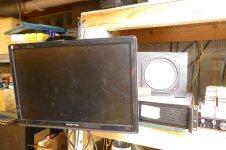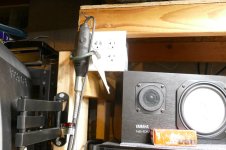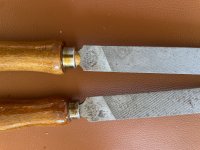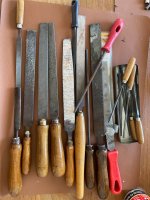Not hell, he got to “feel” the material and learnt how difficult it is to be precise with manual labour.
I still file a lot when doing metal work. It does not get out of your system. It is a positive quality.
I still file a lot when doing metal work. It does not get out of your system. It is a positive quality.
Last edited:
I do as well, but for fine work. Yes, it is difficult and takes time. Removing a lot of material can be very imprecise. Not to mention extremely time consuming.
😂😂Wow.
High school is where we made metal objects on lathes. Cut external threads, tapped holes. I may still have a metal hammer I made so long ago. Made stools and other things in wood shop, I have boards I made in electronics shop and we fixed our cars in auto shop. Bluing ink. Yeah. By the way, it is excellent acid resist ink. I used it for years.
In uni, we built a receiver. We made each PCB and the chassis on our own. Then we made a bread board in a chassis with connectors and pots along the front. Again, we built the chassis ourselves. Never were we expected to file metal bar stock or make anything true and square. Bonsai, you went through hell!
I couldn't remember the name until you posted it. Thats the stuff we used to make sure the cylinder head and engine block were flat or at least warped in the same manner to match. Sometimes the results meant "send both out to the machine shop" or "maybe we can fix these here." A thick composition head gasket can fix some mismatch depending on where it was.We still use tubes of Prussian Blue
The other top secret engine building material was Play Doh. Stick a layer of that stuff on top of the piston test assemble the head to the block with valves, any available valve springs that fit, and pushrods or cam and drive sprockets (depends on the engine). Hand turn the engine over slowly then take the head back off. The piston to valve clearance will be revealed in the Play Doh. You really don't want a valve to hit a piston. It will ruin your day and your engine. Valves can grow a bit when hot and so can the connecting rod, so it is wise to know what clearance is needed for a particular combination. Every hot rod camshaft has lift specs but no two are exactly the same and there is some variance from cylinder to cylinder in the same engine, especially with old blocks.
I wasn't taught how to use a file properly.....
I still file a lot when doing metal work
I do as well, but for fine work. Yes, it is difficult and takes time. Removing a lot of material can be very imprecise. Not to mention extremely time consuming.
I have no patience, I go straight for the Dremel tool, or for big jobs a grinding wheel chucked int a hand drill or even the drill press. I put up with the metal, plastic, and wood work so I have something to house my electronics projects.
LOL!
George - right on!
"Plastigauge" is what we used for bearing clearance. Playdoh or putty could be used for mating surfaces in engine blocks. Bluing ink was so valuable to machining.
Yeah, too much to do to patiently file away anything. My dremel tool is on a hook on the bench.
George - right on!
"Plastigauge" is what we used for bearing clearance. Playdoh or putty could be used for mating surfaces in engine blocks. Bluing ink was so valuable to machining.
Yeah, too much to do to patiently file away anything. My dremel tool is on a hook on the bench.
I forgot that name too. Put a piece in between the crankshaft and the bearing, torque to spec. disassemble and place the squashed Plastiguage on the measuring card or measure its width. The squashed width tells you the bearing clearance."Plastigauge" is what we used for bearing clearance.
Behind that dirty old PC monitor from the late 90's lies a Dremel hanging from a screw. There is an extension cable for remote destruction without taking the Dremel off its hook. The monitor is on a swing out mount so it can be moved out of harm's way, or for unobstructed listening to my 80's vintage Yamaha NS-10M Studio Monitors. The PC is for amp testing. It also works good as a music player and is also quite old (in computer years) with a 2013 vintage Core i5-4690K chip.Yeah, too much to do to patiently file away anything. My dremel tool is on a hook on the bench.
Attachments
IMHO a Dremel can not do what a file can do. The Dremel may take away most material but then a file is needed for a nice finish.
BTW I notice various types of cast aluminium casings now not being suitable for powder coating anymore. Never had issues before. Got some casings back and the powder coating had bubbles because of melting particles in the casings material. Since the powder coating is done at 200 degrees Celsius my guess is that the casings have contaminations with recycled metals with lower melting point.
BTW I notice various types of cast aluminium casings now not being suitable for powder coating anymore. Never had issues before. Got some casings back and the powder coating had bubbles because of melting particles in the casings material. Since the powder coating is done at 200 degrees Celsius my guess is that the casings have contaminations with recycled metals with lower melting point.
Last edited:
BTW, my son has just qualified as a diesel plant mechanic and they still use Plastigauge for engine building.
One tool that's great for bulk 'filing' is a benchtop combination belt/disc sander. I use it a few times a week for both wood and metal. Then where necessary, I use a file to tidy up and put a fine finish on the edge, in particular, draw filing with a fine file.
One tool that's great for bulk 'filing' is a benchtop combination belt/disc sander. I use it a few times a week for both wood and metal. Then where necessary, I use a file to tidy up and put a fine finish on the edge, in particular, draw filing with a fine file.
I still have all kinds of files ... including the Bastard file. Even very small, fine files for detail work. I use those most often.
The dremel is best for finishing cuts on screws and bolts after shearing them, shortening motor shafts, removing finish coatings and similar tasks.
The dremel is best for finishing cuts on screws and bolts after shearing them, shortening motor shafts, removing finish coatings and similar tasks.
Years ago I was at a market where an old guy sold many brand new NOS/NIB Nicholson files. Wrapped in oiled paper, never opened. Just the files, no handles. Then he told me they were 1 Euro each.
Still use these as they are the best I have. Gave them permission to rust in their spare time but they all refused.
Still use these as they are the best I have. Gave them permission to rust in their spare time but they all refused.
Attachments
Last edited:
I now have two file racks for (non-needle) files. I've just checked and find I have 34 different files. Accurate hand work takes care and time but allows you to make any shape you like. Last year at a car boot sale I found a lovely very fine cut 6" file for £1. Bargain! By the way, if you buy Vallorbe needle files, you will find that each profile is available in different cutting coarseness (numbered 1-6). I have no connection with Vallorbe, but their files are far superior to the un-named tat that you find elsewhere. If it's worth your time to do it, it's worth having good tools.
Hand work is speeded greatly by using a coarse file to remove the bulk of the material then working down to finer files for the last bit of accuracy. I haven't yet needed to scrape anything, but I can see the need for that skill looming on the horizon.
We didn't make a receiver, but we did make an oscillator on strip board. Sorry, three transistor common emitter video amplifier with buckets of global feedback that was unforgiving of poor layout. We also folded up a tin plate box to contain said amplifier, fitted it with BNCs, and tested it with a pulse and bar video signal. For dealing with EMC issues, tin plate is wonderful stuff in conjunction with self-adhesive copper tape (buy it as slug tape from gardening suppliers as it's cheaper than from an electronics factor). Tin plate cuts very nicely with a guillotine (if you have one), but also with tin snips (or even scissors). A couple of bits of angle aluminium in your vice allows you to fold tin plate neatly. I make all sorts of boxes and screens from the stuff.
Hand work is speeded greatly by using a coarse file to remove the bulk of the material then working down to finer files for the last bit of accuracy. I haven't yet needed to scrape anything, but I can see the need for that skill looming on the horizon.
We didn't make a receiver, but we did make an oscillator on strip board. Sorry, three transistor common emitter video amplifier with buckets of global feedback that was unforgiving of poor layout. We also folded up a tin plate box to contain said amplifier, fitted it with BNCs, and tested it with a pulse and bar video signal. For dealing with EMC issues, tin plate is wonderful stuff in conjunction with self-adhesive copper tape (buy it as slug tape from gardening suppliers as it's cheaper than from an electronics factor). Tin plate cuts very nicely with a guillotine (if you have one), but also with tin snips (or even scissors). A couple of bits of angle aluminium in your vice allows you to fold tin plate neatly. I make all sorts of boxes and screens from the stuff.
I was surprised when I took a look through my shop and only found 42 files. They range from a set of needle files to half a dozen bastard files. The bit I learned was I need to have a chat with some of the folks who use the shop about neatness and proper storage of tools.
When I get really ambitious I will count screwdrivers!
When I get really ambitious I will count screwdrivers!
Hi EC8010,
Nice tip on the needle files. I normally just buy new sets of cheap ones. I always have a new set waiting to be abused!
Also, great tip on the copper tape. I was buying from the usual suspects, until I found it on AliExpress. I get copper sheet from roofing guys. As for the "oscillator" many of you built, we did as well. Many of the guys had never built anything before - with predictable results.
Hey simon7000,
Retired by chance? 🙂
Nice tip on the needle files. I normally just buy new sets of cheap ones. I always have a new set waiting to be abused!
Also, great tip on the copper tape. I was buying from the usual suspects, until I found it on AliExpress. I get copper sheet from roofing guys. As for the "oscillator" many of you built, we did as well. Many of the guys had never built anything before - with predictable results.
Hey simon7000,
Retired by chance? 🙂
- Home
- Member Areas
- The Lounge
- Filing School




